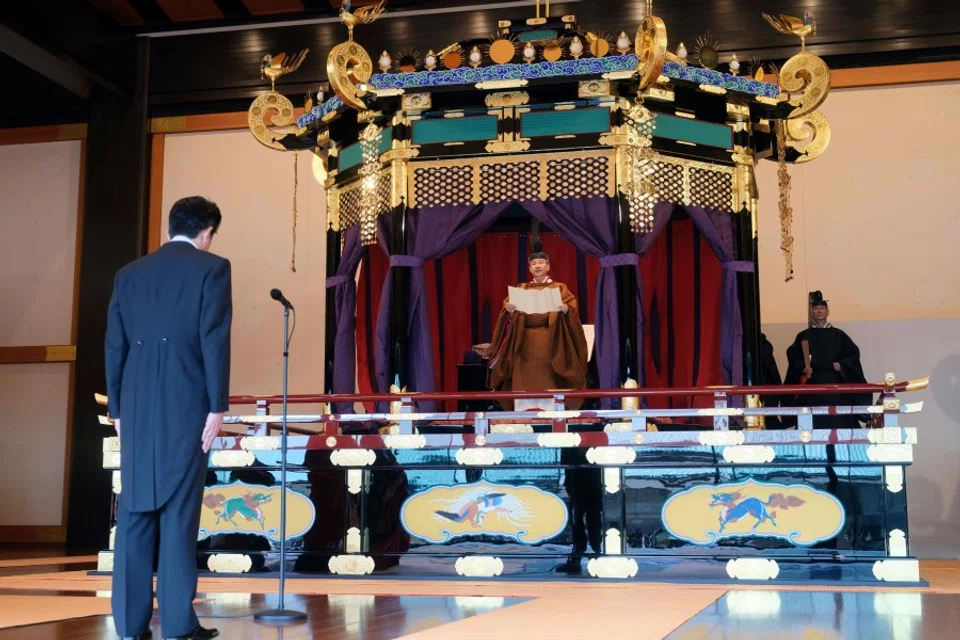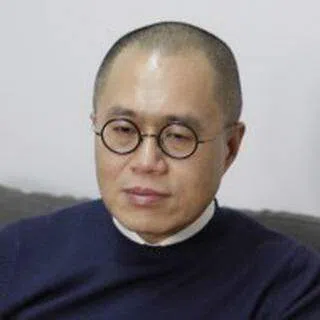Perfect harmony: The Japanese emperor's yellow robe and the prime minister's tailcoat
Japan is able to seamlessly meld tradition with modernity, Hong Kong political commentator Leung Man-tao observes. How do the Japanese decide what are the things to treasure and what are the things to cast off? How is it that China has not been able to do the same as well as Japan? Leung shares his thoughts after reading writer Lo Fung's book, Geopolitical Japan.

Although I don't count myself as a Japanophile, I have unwittingly collected hundreds of books about the Land of the Rising Sun over the decades. At least half of these were written by Chinese. Understandably, when I received the manuscript of Lo Fung's book Geopolitical Japan (卢峰,《地缘日本》), the first question that came to my mind was: "Do we really need another book on Japan?"
Thinking further, the right question to ask is probably this: "Why have the Chinese literati been writing about Japan constantly over the last hundred years or so?" Could the reason be that, as Lo Fung says, the Japanese are apparently always able to combine the traditional and the modern perfectly and effortlessly?
This particular point draws out other questions that have troubled us for nearly a century. Exactly what are the things that should be treasured? What are the things that should be cast off? Why is it that when a house is built out of fair-faced concrete with no architectural features distinctive of Japanese tradition, it nevertheless can still strike us sometimes as extremely Japanese at first glance? And why is that we, on the other hand, in building constructions with modern techniques often have to strain ourselves excessively and throw in eye-catching decorative details before some degree of "Chinese-ness" manages to become discernible?

The coexistence of tradition and modernity
But, of course, the most refreshing thing about Lo Fung's book is that Hong Kong is incorporated in the big picture he paints about cultural shifts. This is seen, for example, in how Commodore Matthew C. Perry's "black ships", responsible for forcing open Japan's closed doors, had to make a choice between Macau and Hong Kong. The fleet had to consider which of these two would be the best way station to stop at before sailing onward to Japan.
In the eyes of the majority of the Chinese people, the best exemplar of how tradition and modernity might coexist is still Japan.
Another case in point is when the Satsuma Domain (what is now part of Kagoshima prefecture), set out to widen the horizon of their young leaders. The Domain, which dominated Japan's political scene during the Bakumatsu and Meiji period, secretly sent students abroad to learn from Europe, and the place where they experienced the charms of the West for the first time was none other than Hong Kong.
We can only surmise: could it be that Hong Kong itself has its own good stories about Chinese-Western fusion? Unfortunately our stories and what we have built up over time - including even observable experiences - obviously cannot be shared by all of China. In the eyes of the majority of the Chinese people, the best exemplar of how tradition and modernity might coexist is still Japan.

Let's take Emperor Naruhito's enthronement ceremony for example. During the morning ritual of Sokuirei-Seiden-no-gi, the emperor, the empress and the courtiers around them wore classical attire that could be traced back to Japan's Heian period. The Prime Minister standing before them, however, wore a Western-style tailcoat. In the evening of the same day, during Kyōen-no-gi - a banquet thrown for the international guests - the menu mainly revolved around Japanese food. Every guest was gifted a small, exquisite silver box, which contained the very traditional Japanese candy known as konpeitō; yet the box itself was named with a French word: bonbonniere. The fact is: nearly a hundred years ago, when it was the Showa Emperor's turn to take the throne, foreign emissaries attending the event were already marvelling at how expertly the Japanese seemed to combine their traditions with protocols assimilated from the West.
Back to the present, take the procession set-up for the imperial parade for example. At the front were Shinto priests holding up banners, while the emperor rode in behind them in a Western-style horse-drawn carriage. When we think about it, we may be tempted to call all this an outlandish combination. After all, here is a convergence of things from the past and present, as well as from the East and the West. But why does it seem so harmonious to us anyway?
At one point in his book, Lo Fung discusses Junichirō Tanizaki's masterwork In Praise of Shadows, which is famous for its criticism about how traditional Japanese aesthetic culture was gradually losing ground to the encroaching wave of the West. He says Tanizaki was actually "not an archaic stony mountain (so to speak) totally opposed to Westernisation. He would candidly admit that Western technology and civilisation brought benefits and conveniences. In his daily life, he would make use of them even as he was grumbling inside. In some cases, such as that of dentistry tools, he could not help but acknowledge that the Western ones were more advanced and reliable."

So the questions remain: what are the things that should be kept? What are those that should be Westernised? Tanizaki did not offer a clear set of criteria to resolve these. The Imperial Household Agency, which oversees all matters great and small of the Japanese Imperial House, is well-known for being conservative and does not have any well-defined rules for making precise judgements - judgements regarding issues like why, as a traditional Japanese candy was being gifted to foreign guests, the box containing it had to be designated by a French term.
"Japanese Spirit, Western Learning"
...the Japanese had never been able to self-consciously consolidate on an intellectual level all they had accumulated culturally into a set of traditions complete with principles, strata and structures.
Masao Maruyama, a towering figure in the intellectual history of modern Japan, had asserted in his book Japanese Thought that the intellectual tradition of his country was "structureless". It was characterised thus: "We would rather say that precisely because things of the past had not been consciously treated as an object vis-à-vis others, and therefore cannot be 'sublated' by the present, the past sneaks into the present from behind. The failure of thought to accumulate into tradition and the unconscious seepage of traditional thought into early modern Japanese practices are really two sides of the same thing."

Simply put, the Japanese had never been able to self-consciously consolidate on an intellectual level all they had accumulated culturally into a set of traditions complete with principles, strata and structures. In contrast, the Europeans might think of their past in terms of a tradition that marries Greek civilisation with the Christian faith. The Chinese could consciously associate their own past with a Confucian tradition. In each of these two cases, we can identify some sort of mainstay of a legacy of thought, which may be established as an axis of reference. Everything else inconsistent with this mainstay can be regarded as its branches, fringes or refutations.
Thus, when China was faced with an influx of Western culture in the early modern era, the Chinese intelligentsia could very consciously make sense of the situation in terms of a face-off between, on the one hand, a tradition of Confucian propriety and teachings and, on the other hand, Western modern civilisation.
But what about Japan? On the epistemic level, the Japanese had never been able to say exactly what sort of intellectual tradition theirs was, and so when they came face to face with Western modernity like we did, they were not able to form an understanding akin to ours as a reflective response.
While they did speak of "Japanese spirit, Western learning" (和魂洋才 wakon yōsai), a tenet superficially very similar to Qing China's notion of "Chinese learning as essence, Western learning for application" (中体西用 zhongti xiyong) , what exactly did this "Japanese spirit" refer to? No one beyond a handful of philosophers had been able to articulate it clearly, nor had the idea become widespread in Japanese society. Thus there was fundamentally never a general face-off between tradition and modernity, or the Japanese and the Western.
Not having any set of very consciously recognised, traditional ideas formed over a long time, the Japanese are able to juxtapose all that is new and old, and see all things past and future as devoid of any temporal background...
I venture to quote Masao Maruyama again: "Because new or essentially alien things were taken in without a complete confrontation with the past, the new won a shockingly early victory. We are left unable to see the past as such and make it face the present self-consciously. The past is thus pushed aside, or made to sink to the bottom, and thereby disappears from our consciousness."
Since there was no self-conscious tradition that is capable of posing any resistance, open inroads made by any foreign item on a grand scale become possible. At best there may be individuals like Junichirō Tanizaki, who would complain about some foreign introductions on the affective level. However, precisely because of this, many legacies from the past came to be "remembered" suddenly in a totally disconnected manner.
Take, for example, some of the richly Japanese aesthetic categories that many are well-acquainted with today (to the point of even being tossed around as catchy terms), such as "wabi-sabi" and "mono no aware". All of a sudden they become amenable to being grafted onto that which are highly Westernised or modern.

While post-Meiji Japan seems so modern (or even ahead of its time) in many aspects, why is it that it also retains many of its old traditions obstinately? Not having any set of very consciously recognised, traditional ideas formed over a long time, the Japanese are able to juxtapose all that is new and old, and see all things past and future as devoid of any temporal background - that is to say, as items placed in different corners in a purely spatial sense.
To put it even more simply, the Japanese-style "fusion of the new and old" that has often drawn our admiration and envy is, in reality, just a mix-and-match of various parts from the West and Japan, from the traditional and the modern. Just as Shinzo Abe's tailcoat and Emperor Naruhito's korozen no goho (a brownish-yellow imperial robe dyed using the bark of the Japanese wax tree and sappanwood) could be put in the same room and remain at peace with each other.
But, of course, I am only surmising. Is all of the above really true? Lo Fung himself does not give us an explicit answer. Nevertheless, he has fulfilled his responsibility as a deeply observant traveller. True to himself as a senior media practitioner, he not only thoroughly explored locations overlooked by most tourists, but also revisited places he had been to in the universe of texts. Thanks to his efforts, our inquiries are endowed with additional breadth and depth through the multilayering of time and space.




![[Photos] Fact versus fiction: The portrayal of WWII anti-Japanese martyrs in Taiwan](https://cassette.sphdigital.com.sg/image/thinkchina/3494f8bd481870f7c65b881fd21a3fd733f573f23232376e39c532a2c7593cbc)

